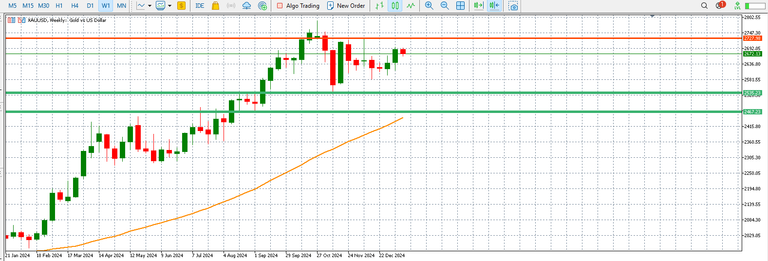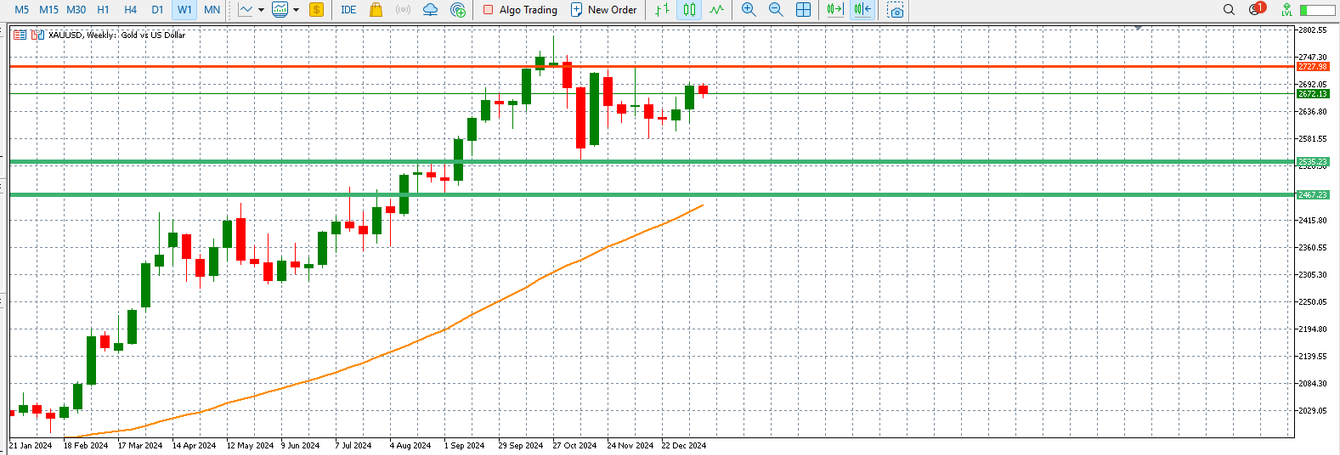With two straight weeks of advances, gold has given traders and investors some optimism within a more erratic economic scene. Gold has held its footing in spite of a strong U.S. dollar and anticipations of tighter monetary policy after the Friday publication of economic statistics. But as the new week gets underway, the precious metal finds itself beginning on the back foot as traders adjust their positions and evaluate the most recent economic data that may be absolutely crucial in determining the direction of Federal Reserve monetary policy.
The Gold Recent Price Action
Although the dollar surged noticeably after the publication of important economic data last Friday, gold's price behaviour has been remarkable in recent weeks as the metal managed to guarantee two straight weeks of gains. The report showed more than anticipated, which caused traders to change their projections on the Fed's near future interest rate policy. Notwithstanding this, gold's resiliency is still remarkable as it is still a safe-haven asset in unstable markets.

The trading gold chart from MT4 trading platform shows important price level for trader on the daily time frame.
But gold prices began the week on a more wary tone. Particularly because fresh important economic data will be published this week, traders are reevaluating the consequences of Friday's numbers. These studies, including U.S. Non-Farm Payroll (NFP) statistics and inflation indicators such the Producer Price Index (PPI) and Consumer Price Index (CPI), are predicted to be very important in determining the market attitude for gold in the next days.
What does the U.S. NFP data mean for gold?
With the actual figure coming in at 256,000 new jobs created, much more than the projection of 164,000, the Friday U.S. NFP report revealed demonstrated a stronger-than-expected performance. The fact that the unemployment rate fell to 4.1%, surpassing projections of 4.2% helped to confirm this as well. The headline declining unemployment rate has made traders rethink their view on gold, particularly considering the fact that robust labour market statistics might indicate that the Federal Reserve has less justification to lower interest rates much further.
The publication of the NFP statistics has had a major influence on the situation of gold. Given the stronger-than-expected employment data, which imply the Fed would hold off on rate reduction this month, traders are now wondering about the viability of the positive gold price trend. Actually, the likelihood of a January rate drop is at its lowest level ever. Traders are therefore now thinking about the likelihood that, if at all possible, the Fed would only lower rates twice for the remainder of the year. This change in expectations has caused gold's trajectory to be re-examined as the commodity usually performs best in a low-interest-rate environment.
Coming data this week: CPI and PPI.
Looking forward, the attention now moves to the important economic data for this week, which can influence gold's price movement and change market attitude. The Consumer Price Index (CPI) will be published on Wednesday; the Producer Price Index (PPI) will be published on Tuesday. Whereas the CPI is predicted to reflect a year-on- year rise of 2.9%, compared to the prior number of 2.7%, the PPI projection is 0.4%. Although the threshold for inflation has already been set somewhat low, there is a genuine chance that inflation will surprise on the upward side, which would not be good for gold prices.
Should the CPI statistics show 3% or over, the market may go into frenzy. Such a high inflation figure would probably cause markets to believe that the Fed has no justification to further modify its monetary policy, therefore shutting the door to any additional rate reduction. Higher inflation would also imply that the Fed could be compelled to remain hawkish, thereby maintaining rates higher for longer, which would be negative for gold. Traditionally seen as a counter to inflation, gold might find it difficult to maintain its upward pace if data on inflation pointed to continuous price pressures.
The Effect of Trump's Coming Back to Office
Former President Donald Trump is expected to be back in the White House next week, which might have major ramifications for American monetary policy. Trump has been vocal in his criticism of high interest rates, therefore his return to power gives optimism for a change towards more dovish monetary policy. Particularly in order to increase economic development, there is conjecture that Trump's government would advocate reduced interest rates.
Should Trump genuinely urge the Federal Reserve to lower rates or take a more accommodating posture, gold prices would rise. Since gold does not generate income unlike bonds or savings accounts, lower interest rates would make it more appealing. Therefore, any dovish signals from the Fed or the U.S. government may inspire fresh optimistic attitude in the gold market, therefore maybe driving prices higher. Still, this is hardly clear, and much will rely on how the political environment and economic statistics develop in the next months.
In essence,
The price behaviour of gold has been evidence of its function as a safe-haven asset, surviving the storm of a rising currency and a shifting macroeconomic scene. Though with some caution as the new week starts, gold has managed to show increases while recent economic data has slowed hopes for more Fed rate reduction. The publication of important inflation figures this week together with the continuous uncertainty about U.S. economic policy will probably influence the direction of gold. Traders will be keenly observing if inflation surprises to the upside, thus stopping the upward momentum in gold, or whether economic data force the Fed to take a more dovish posture, so providing more support for the precious metal.
The future of gold prices is still unknown but bright as the market absorbs these elements; particularly, should Trump's return to power provide more favourable policies for the yellow metal, then Gold will probably be a prominent asset to keep an eye on in the next months with a delicate mix of inflation statistics, Fed policies, and political changes.
